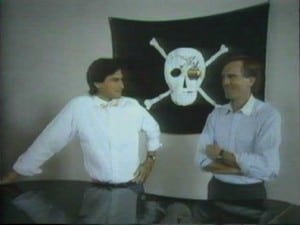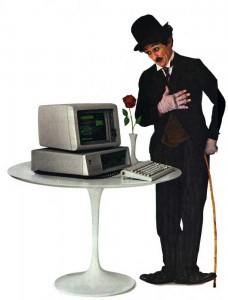The Apple Macintosh had not been a success from the outset. The hardware was not designed particularly generously for the requirements of a graphical user interface. Especially the main memory had been calculated rather tightly. Moreover, there was no hard disk for the Mac at that time.
“The original 128K Mac had too many problems to list,” wrote Jack Schofield from the Guardian 20 years later in an article about the 20th anniversary of the apple Macintosh. “It had too little software, you couldn’t expand it (no hard drive, no SCSI port, no ADB port, no expansion slots), it was horribly underpowered and absurdly overpriced. The way MacWrite and MacPaint worked together was brilliant, but producing anything more than a short essay was a huge struggle. Just copying a floppy was a nightmare.” In addition, there was a lack of appropriate business software.
The Mac lacked the applications that dragged the Charlie Chaplin figure across the screen box by box in the IBM’s advertising spot for the PC. Therefore, Guy Kawasaki and other “Software Evangelists” of Apple made an effort to convince the developers of other software companies to write programs for the Mac. The Mac’s ROM, which had been calculated far too narrowly at 128 kilobytes, did not make this a simple task. Not until the “Fat Mac” with 512 kilobytes was launched one year after the first Macintosh had this narrow bottleneck been removed.
The problem came to a head when by the beginning of 1985, the Macs that had not found purchasers during the Christmas sales of 1984 were piling up in storage. Apple had to publish the first quarterly loss in the company’s history and release a fifth of the staff. During a marathon meeting on April 10 and 11, 1985, Apple’s CEO John Sculley demanded to have Steve Jobs relieved of his position as an Apple vice president and general manager of the Macintosh department.
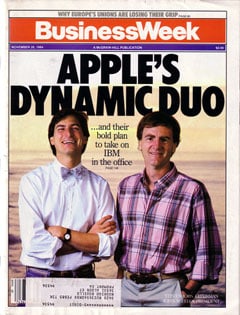
According to Sculley’s wishes, Steve Jobs was to represent the company externally as a new Apple chairman without influencing the core business. As Jobs got wind of these plans to deprive him of his power, he tried to arrange a coup against Sculley on the Apple board. Sculley told the board: “I’m asking Steve to step down and you can back me on it and then I take responsibility for running the company, or we can do nothing and you’re going to find yourselves a new CEO.” The majority of the board backed the ex-Pepsi man and turned away from Steve Jobs.
On May 31, 1985, Jobs lost his responsibilities and was shuffled off to the chairman position. In September, the Apple co-founder left the company with a few people in order to found NeXT Computer. “I feel like somebody just punched me in the stomach and knocked all my wind out. I’m only 30 years old and I want to have a chance to continue creating things. I know I’ve got at least one more great computer in me. And Apple is not going to give me a chance to do that,” Jobs wrote to Mike Markkula on parting. Ten years later, Steve Jobs also commented on his disempowerment with bitterness in the TV documentary “Triumph of the Nerds” (1996):
Excerpt from the TV documentary “Triumph of the Nerds” with Robert Cringley
Jobs: What can I say? I hired the wrong guy. –
Question: That was Sculley?
Jobs: Yeah and he destroyed everything I spent ten years working for. Starting with me but that wasn’t the saddest part. I would have gladly left Apple if Apple would have turned out like I wanted it to.
Apple’s Heart and Soul
Andy Hertzfeld, one of the Macintosh’s fathers, later recalled the events:
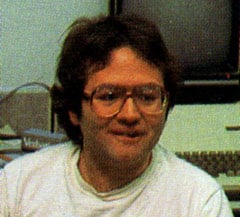
The conflict came to a head at the April 10th board meeting. The board thought they could convince Steve to transition back to a product visionary role, but instead he went on the attack and lobbied for Sculley’s removal. After long wrenching discussions with both of them, and extending the meeting to the following day, the board decided in favor of John, instructing him to reorganize the Macintosh division, stripping Steve of all authority. Steve would remain the chairman of Apple, but for the time being, no operating role was defined for him. John didn’t want to implement the reorganization immediately, because he still thought that he could reconcile with Steve, and get him to buy into the changes, achieving a smooth transition with his blessing. But after a brief period of depressed cooperation, Steve started attacking John again, behind the scenes in a variety of ways. I won’t go into the details here, but eventually John had to remove Steve from his management role in the Macintosh division involuntarily. Apple announced Steve’s removal, along with the first quarterly loss in their history as well as significant layoffs, on Friday, May 31, 1985, Fridays being the traditional time for companies to announce bad news. It was surely one of the lowest points of Apple history.
Hertzfeld mourned for Steve Jobs openly: “Apple never recovered from losing Steve. Steve was the heart and soul and driving force. It would be quite a different place today. They lost their soul.” In contrast, Larry Tessler, who had come to Apple from Xerox, refers to mixed reactions of the Apple staff: “People in the company had very mixed feelings about it. Everyone had been terrorized by Steve Jobs at some point or another and so there was a certain relief that the terrorist had gone but on the other hand I think there was an incredible respect for Steve Jobs by the very same people and we were all very worried – what would happen to this company without the visionary, without the founder without the charisma…”
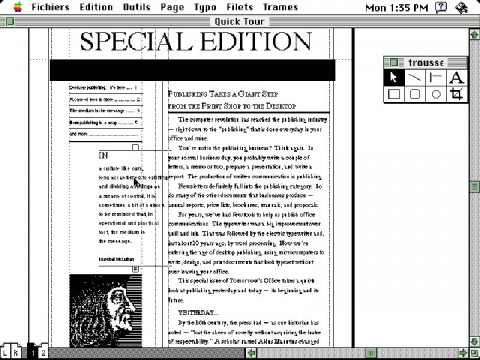
It is an irony of computer history that, according to industry experts, the Macintosh’s breakthrough on the market was becoming apparent exactly at the time of Jobs’ disempowerment due to the Mac’s poor sales volume. The convincing the “Macintosh Evangelists” were doing gradually began to show results.
New software companies such as Aldus had made an effort to become acquainted with the details of the “Macintosh Toolbox” and written the first desktop publishing programs, such as PageMaker. In combination with the Apple LaserWriter and the page description standard PostScript (designed by Adobe), PageMaker turned the technology of the publishing sector inside out; it did even more when the Mac Plus with 512 kilobytes of ROM entered the market by the beginning of 1986.
And it is also an irony of computer history that Jobs later saved the struggling Apple Computer company. NeXT’s subsequent 1997 buyout by Apple brought Jobs back to the company he co-founded, and he has served as its CEO since then.
In an Interview (June 2010) Sculley credits Jobs for everything Apple has accomplished and still laments the way things turned out. “I haven’t spoken to Steve in 20-odd years,” Sculley told The Daily Beast. “Even though he still doesn’t speak to me, and I expect he never will, I have tremendous admiration for him.”
Sculley said in the interview he accepts responsibility for his role but also believes that Apple’s board should have understood that Jobs needed to be in charge. “My sense is that it probably would never have broken down between Steve and me if we had figured out different roles,” Sculley said. “Maybe he should have been the CEO and I should have been the president. It should have been worked out ahead of time, and that’s one of those things you look to a really good board to do.”
In an interview on the subject, Sculley tells Cultofmac.com editor Leander Kahney how his partnership with Jobs came to be, how design ruled—and still rules—everything at Apple, and why he never should have been CEO in the first place.
Looking back, it was a big mistake that I was ever hired as CEO. I was not the first choice that Steve wanted to be the CEO. He was the first choice, but the board wasn’t prepared to make him CEO when he was 25, 26 years old. They exhausted all the obvious high-tech candidates to be CEO. … Ultimately, David Rockefeller, who was a shareholder in Apple, said let’s try a different industry and let’s go to the top headhunter in the United States who isn’t in high tech: Gerry Roche.
They went and recruited me. I came in not knowing anything about computers. The idea was that Steve and I were going to work as partners. He would be the technical person and I would be the marketing person.
The reason why I said it was a mistake to have hired me as CEO was Steve always wanted to be CEO. It would have been much more honest if the board had said, “Let’s figure out a way for him to be CEO. You could focus on the stuff that you bring, and he focuses on the stuff he brings.”
Remember, he was the chairman of the board, the largest shareholder, and he ran the Macintosh division, so he was above me and below me. It was a little bit of a façade, and my guess is we never would have had the breakup if the board had done a better job of thinking through not just how do we get a CEO to come and join the company that Steve will approve of, but how do we make sure we create a situation where this thing is going to be successful over time?
Sculley admitted that he made “two really dumb mistakes” after Steve Jobs left the company:
One was when we were at the end of the life of the Motorola processor … we took two of our best technologists and put them on a team to go look and recommend what we ought to do.
They came back and said it doesn’t make any difference which RISC architecture you pick, just pick the one you think you can get the best business deal with. But don’t use CISC. CISC is complex instruction set. RISC is reduced instruction set.
So Intel (INTC) lobbied heavily to get us to stay with them … [but] we went with IBM and Motorola (MOT) with the PowerPC. And that was a terrible decision in hindsight. If we could have worked with Intel, we would have gotten onto a more commoditized component platform for Apple, which would have made a huge difference for Apple during the 1990s. So we totally missed the boat. Intel would spend $11 billion and evolve the Intel processor to do graphics … and it was a terrible technical decision. I wasn’t technically qualified, unfortunately, so I went along with the recommendation.
The other, even bigger failure on my part was if I had thought about it better, I should have gone back to Steve.
I wanted to leave Apple. At the end of 10 years, I didn’t want to stay any longer. I wanted to go back to the East Coast. I told the board I wanted to leave, and IBM was trying to recruit me at the time. They asked me to stay. I stayed, and then they later fired me. I really didn’t want to be there any longer.
The board decided we ought to sell Apple. So I was given the assignment to go off and try to sell Apple in 1993. So I went off and tried to sell it to AT&T (T), to IBM, and other people. We couldn’t get anyone who wanted to buy it. They thought it was just too high risk, because Microsoft and Intel were doing well then. But if I had any sense, I would have said, “Why don’t we go back to the guy who created the whole thing and understands it? Why don’t we go back and hire Steve to come back and run the company?”
It’s so obvious, looking back now, that that would have been the right thing to do. We didn’t do it, so I blame myself for that one. It would have saved Apple this near-death experience they had.
I’m actually convinced that if Steve hadn’t come back when he did—if they had waited another six months—Apple would have been history. It would have been gone, absolutely gone.

